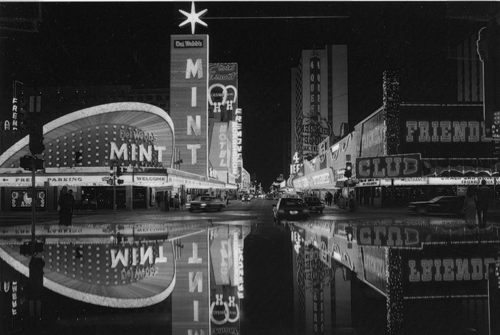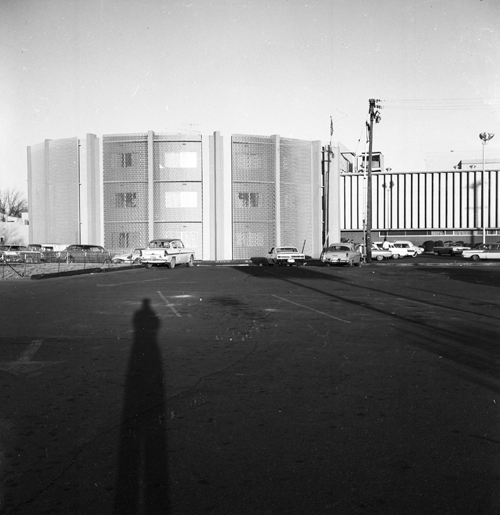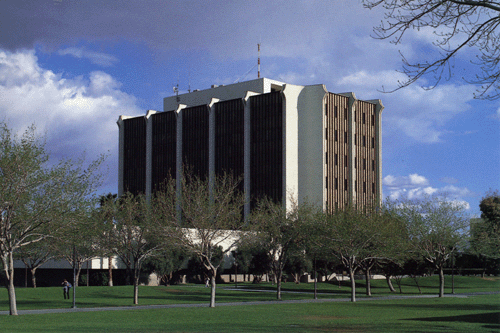For information on our "Beyond the Mint: The Mid-Century Modern Architecture of Walter Zick" event and bus tour, click here
Sad news to report. Casino entrepreneur Bob Stupak passed away on Friday evening. The report from the R-J says:
Bob Stupak, the Las Vegas gaming entrepreneur who defied his critics at every turn, died at Desert Springs Hospital today after a long battle with leukemia. He was 67.
Stupak has been hospitalized since Saturday, said Sandy Blumen, who has two children with Stupak. He died at 1:15 p.m. Friday. Stupak, who staged numerous unsuccessful runs for local political office and is known for his colorful and sometimes controversial behavior, has kept a low profile in recent years as his health deteriorated. Stupak first came to Las Vegas in the early 1970s and opened a restaurant, followed by "Bob Stupak's World Famous Historic Gambling Museum & Casino." In 1979, he opened Vegas World. But Stupak is perhaps best known for building the Stratosphere and the 1,149-foot-tall Stratosphere Tower on Las Vegas Boulevard near Main Street. "Bob was an impresario, a ringmaster in the mold of the promoters who made Las Vegas the great town that it is,” said Las Vegas Mayor Oscar Goodman. “His ingenuity got him into trouble sometimes, but that happens to folks who try to grab the brass ring. "I'll miss his impishness." Stupak excelled in promoting himself and his enterprises and appeared to adhere to the axiom that even bad publicity is good publicity. His exploits made headlines over and over again. Stupak was born April 6, 1942. He grew up in a Polish working-class neighborhood in Pittsburgh. He made his first bet — a penny on the numbers — when he was eight. In the Army, he ran craps games in the barracks at Fort Knox, Ky., and Fort Sill, Okla. He figured out he could also make money with something as simple as a raffle. “I realized that people were prepared to gamble a little if they had a chance to win a lot,” he said in a 1989 interview. “I understood the principles of gambling and the greed factor, which everyone basically has.” The best way to describe him, said College of Southern Nevada history professor Michael Green, "is as a 20th century version of P.T. Barnum. He was a visionary, and what he envisioned, he achieved.” “He was a young man with a pocketful of money and he fell in love” with the city, said Ralph Denton, a longtime Southern Nevada lawyer who met Stupak in the early 1970s. Stupak nearly died in 1995 after crashing his Harley-Davidson motorcycle while going more than 60 mph. His son, Nevada, who was a passenger, also was injured. The elder Stupak broke every bone in his face. Doctors didn’t expect him to live. But Stupak was a fighter and recovered. Still, he was never quite the same and continued to struggle with his health over the years, Blumen said. Review-Journal writer Alan Choate contributed to this report. Memorial contributions At Bob Stupak’s request, he will be cremated and there will be no funeral, a family spokeswoman said. The Stupak family has requested that in lieu of flowers, contributions be sent to the Stupak Community Center in his memory. The Stupak Trust 300 South Fourth St., Suite 701 Las Vegas, NV 89101
Bob Stupak, a Las Vegas legend who developed the Stratosphere and called himself the Polish Maverick, died today at Desert Springs Hospital after a long battle with leukemia.
He was 67.
The Stratosphere released a statement Friday afternoon saying Stupak will be remembered for his contributions to Las Vegas.
“Bob Stupak was a true visionary and he will be sorely missed. He was instrumental in developing the Stratosphere Casino Hotel and Tower – an icon in Las Vegas, as Mr. Stupak was himself. He will be remembered for his many community initiatives and his many innovative projects within the gaming industry," the statement said. "Our thoughts and prayers are with his family.”
After an unconventional boyhood in Pittsburgh he came to Las Vegas, where he survived a motorcycle crash and sparred with gaming regulators. He eventually built the tallest hotel-casino in Las Vegas.
In his early days, Stupak delved into pop music and motorcycle drag racing before he began selling coupon books. His father, Chester Stupak, was a major player in Pittsburgh gambling rackets from before World War II until his death in 1991.
After Bob Stupak dropped out of school following the eighth grade, he bought a Harley-Davidson and began an odyssey that would lead to Las Vegas.
Stupak's interest in gambling drew him to Las Vegas in 1964. He then took a detour to Australia for seven years, where he continued selling coupon books and got married twice. Stupak stayed in Las Vegas for good in 1971.
In 1973, Stupak opened the Million Dollar Historic Gambling Museum & Casino, which burned down under mysterious circumstances. Rising from those ashes, Stupak built Vegas World in 1974, an outer space-themed casino with a display of cash Stupak had won in some of his most notorious gambling bouts, including poker games and big Super Bowl bets.
Media from around the world came to the April 29, 1996, opening of the 1,149-foot-tall Stratosphere. A bronze statue of Stupak was displayed at the resort north of Sahara Avenue on Las Vegas Boulevard.
Stupak had envisioned an 1,800-foot tower, but the Federal Aviation Administration intervened and prevented him from going that high. Less than three months after the Stratosphere opened, Stupak, a 14 percent owner, resigned as chairman and the bronze statue disappeared. Stupak said later he had never authorized it.
On March 31, 1995, Stupak was nearly killed when the Harley-Davidson motorcycle he was driving collided with a vehicle on Rancho Road, leaving him in a coma for five weeks.
Stupak had attempted to enter the political arena by running for mayor of Las Vegas. He also helped his daughter, Nicole, with a failed bid for a City Council seat in 1991.
"It seems like he was always playing it right to the edge -- good, bad or indifferent," said former United Press International Bureau Chief Myram Borders, who covered Stupak during the years of his greatest contributions to Las Vegas history. "He had a good sense of humor. He was a funny man. Bob seemed to enjoy life very much."
In 1989, Stupak won the World Series of Poker $5,000 buy-in no-limit deuce-to-7 world championship at Binion's Horseshoe, earning a purse of $139,500. He had placed third in that same event in 1984 and would go on to place fourth in that game at the 1991 and 1993 World Series of Poker.
Famed Las Vegas oddsmaker Lem Banker called his longtime friend "a visionary."
"Bob was a decathlon gambler -- sports bets, propositions, poker -- everything at once," Banker said. "He had a lot of heart and a lot of brains."
Sen. Harry Reid said in a statement that he was saddened to learn of Stupak's death, adding that they had been friends for 35 years.
"Las Vegas has seen many visionary people come and go throughout the years, but few personified the town like Bob did. He was a genuine Las Vegas character," Reid said. "My thoughts and prayers go out to Bob's family and friends during this difficult time."
Our thoughts and prayers are with his family.







